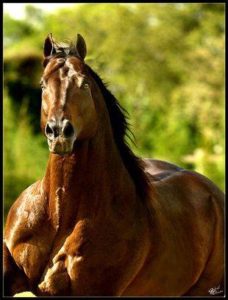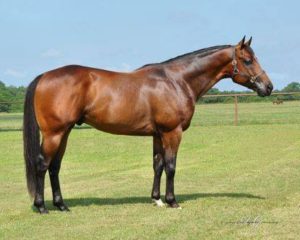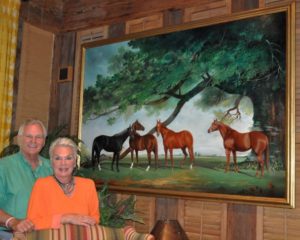By Barbara Newtown.
J. E. Jumonville, Quarter Horse and Thoroughbred racehorse owner and breeder, lives with his wife Bunny on their farm in Ventress, Louisiana, 30 miles northwest of Baton Rouge. Jumonville Farms covers over 1,000 acres; about 200 acres are dedicated to horses and hay, and the rest is leased out for sugar cane cultivation. The land is lush and flat and located between the False River and the Mississippi. The land is safe from flooding—as long as the Mississippi levee never gives way.
J. E. learned about horses from his uncle, who showed in cutting competitions and used horses in his cattle operation. J. E. says, “I traded a bull for my first racehorse, Go Far Wonder, when I was in my 20s. I was blessed from the get-go. That horse ran 3rd in his first race, two weeks later ran 4th, and then he won 5 races in a row. I got excited about racing and started reading books and learning about it. He was just a claiming horse!”
That claimer’s winnings were the beginning of Jumonville Farms. Over the next seven or eight years, J. E. put together 18 different tracts of land.
J. E. served as a senator in the Louisiana legislature from 1976 to January 1992. The governors of Louisiana during that time were Edwards, Treen, Edwards again, and Roemer. J. E. says: “When I served, everyone tried to work together to accomplish things. We weren’t there to obstruct. We didn’t get everything we wanted, and the other party didn’t get everything they wanted, but when we came out of it we had something that was better. Today, if a Democrat is for something, every Republican is against it, and vice versa. They call it gridlock and it is just ridiculous… But we do have a good racing program in Louisiana!” During his time as a senator, J. E. sought to bring together the Quarter Horse and Thoroughbred racing worlds. It was a tough sell, but he helped set in motion rule changes that extended Louisiana Horsemen’s Protective and Benevolent Association benefits to Quarter Horse members, that required the LHPBA to represent both QH and TB associations in contract negotiations, and that required licensed racing associations in Louisiana to return 50% of their gross handles to horsemen in the form of purses.
J. E.’s good luck with horses continued. The first yearling he bought won the richest race in Louisiana in 1971. An incomplete list of the nationally-ranked racehorses bred and/or owned by Jumonville Farms over the years includes Champion Lady Juno, Justanold Love, Queen for Cash, Dashingly, Truckle Feature, Leading Star, Marketina, Louisiana Girl, Sgt Pepper Feature, Feature Mr Jess, Jess Louisiana Blue…
J. E. also continued his personal interest in showing cutting horses. He and his mare Dry Dot performed well in amateur and open regional competitions. In 1982 the pair placed third in open cutting at the National Cutting Horse Association Super Stakes. The mare sold for $250,000 just before J. E. rode her in the non-pro division—which he and Dry Dot won. Rumor has it that J. E. tried to buy her back after the win.
The story of Laughing Saint, a 2007 Thoroughbred filly J. E. bought in Kentucky, illustrates how pedigree and conformation and intuition work together to produce winners… and how Thoroughbred and Quarter Horse lines can mingle to produce sheer speed. When J. E. and Bunny were visiting with Hall of Fame Thoroughbred trainer Bob Baffert in California, he showed them the two-year-old stallion Vindication by Seattle Slew.
Vindication (horseracingnation.com):
“I liked Vindication,” said J. E. “He went on to win the Breeders Cup Juvenile in 2002. He got hurt and didn’t run in the Kentucky Derby, and only bred for one or two years before he died.” A few years later in Kentucky, J. E. remembered how impressed he had been by Vindication when he saw one of his daughters up for auction. “There weren’t many of his daughters, but I thought I’d like to have one. I liked her bottom side. I liked her conformation. Those three things together got me to buy that filly, Laughing Saint.”
J. E. didn’t break Laughing Saint until she was 3—she was little and a late bloomer. He put the filly in Thoroughbred training and discovered that she was a bleeder. “I was afraid to race her so I never did. Well, we had never bred a Thoroughbred to a Thoroughbred. We had always bred Thoroughbred mares to our Quarter Horse studs, but I wanted to breed this mare to a Thoroughbred in Louisiana. It was early in the breeding season and I was still looking around and just couldn’t make up my mind… My son Dutch had the vet here one morning, and he called me and said, ‘That mare is a breeder today,’ so I said, ‘Well, just go ahead and breed her to Jess Louisiana Blue.’ Dutch said, ‘You think that will work?’ and I said, ‘We are just going to try it and see.’ We raised that foal, sold it as a half Quarter Horse half Thoroughbred at the Louisiana Yearling Breeder’s Sale, and that horse, Jess A Saint, went on and won the million dollar Louisiana Quarter Horse Breeders Futurity in 2015.”
Jess A Saint (lqhba.com):
One day this spring the Senator, Dutch, and I piled into their Mule 4-wheeler and took a tour of the Jumonville land. A railroad track cuts across the property and separates the horse operation from the cane. J. E. stopped the Mule right on top of the raised crossing to give me a panoramic view of the farm. We looked over the cane fields and the pastures…and had a moment of mirth when I leapt from the Mule when J. E. paused on the tracks. (I’m a New Yorker: tracks are dangerous!)
We stopped in a field of robust Quarter Horse yearlings, destined for auction and a racing career. They crowded around, polite and friendly, sniffing the Mule and our sleeves. Dutch credits “Mrs. D.” with the good behavior of the youngsters. He said that he and Mrs. D. try to get their hands on the babies and yearlings every day. “When people meet the young ones, they’re like, ‘Wow!’ because the horses are not afraid.” Mrs. D. is responsible for keeping track of medical information for the babies—shots, wormers, etc. She also does the night shift, watching out for mares in labor. Although the farm uses a Foal Alert system, Mrs. D. “still likes to get up every hour or two and check the mares. Our night watch does a very good job!”
We then toured the paddocks, most of which held mares and foals.
The Senator examined each baby with an eagle eye, looking for bruises, off steps, changing leg angles, and, a particular dislike of his, chewed tails. “A chewed tail knocks down the auction price,” he said. “It shouldn’t matter, but it does.” He spied a shortened tail on a foal who shared a paddock with another mare and baby. “He and his mom need to be by themselves,” he said to Dutch.
We stopped by a paddock with a big, stout, dark brown stallion. “That’s Jess Louisiana Blue,” said Dutch. “He’s 19. We raised him. His babies have proven themselves on and off the track. He’s had several big runners and even some barrel world champions. He’s a Godsend to us. It’s a blessing to have him!”
I noticed his substantial bone. “He’s a solid horse,” I said.
“Yes, ma’am, and he throws it on his babies, too. He’s a level-headed stud horse, a real gentleman,” said Dutch.
Jess Louisiana Blue (jumonvillefarms.com):
The other two stallions at Jumonville Farms are Sizzling Cartel (by Corona Cartel) and Feature Mr Bojangles (by Feature Mr Jess). “Sizzler,” a bay, won the Firecracker Futurity and came in second in several other futurities and derbies. “His first crop ran last year, and I think he had 10 winners out of 16 starters, and several futurity finalists. He looks like he’s going to be a very nice stud.”
Sizzling Cartel (photo: Amanda Glidden):
Feature Mr Bojangles is new to Jumonville Farms. Dutch and his father bought the eight-year-old sorrel stallion at last year’s fall mixed sale in Oklahoma. “He’s a two-time Grade 1 winner. He earned $899,000. Very good family. And he’s new to Louisiana.” Dutch said they’ve had a great response from outside mare owners. (Jumonville Farms usually doesn’t board mares; instead, Dutch collects the stallions and ships the fresh, chilled semen.)
Feature Mr Bojangles (stallionesearch.com):
Acquiring Feature Mr Bojangles was good business—but it was also a gesture of respect for his deceased sire, Feature Mr Jess, who was bred by Jumonville Farms. J. E. said, “Feature Mr Jess is an accredited Louisiana-bred. I sent him to a trainer in Oklahoma and he did very well. He won the Rainbow Futurity at Ruidoso Downs and came back the next year and won the Rainbow Derby. No other Louisiana horse has ever won a Grade 1 race at Ruidoso, and Feature Mr Jess won two of them. We had to put him down at age 10. We haven’t had a foal from him since 2001 or 2002, and he’s still ranked high: he is the only stud in the country with two horses in the top 11 money winners in the history of the business.”
Feature Mr Jess:
The Jumonvilles think so highly of Feature Mr Jess, a leading sire by a leading sire (Mr Jess Perry), that they have recently arranged to purchase all of the deceased horse’s frozen semen. The fertilizations will be assisted by the ICSI technique, which allows a veterinarian to inject a single sperm into the ovum. The main advantage of “intracytoplasmic sperm injection” is that the veterinarian can identify and isolate a sperm that is active, moves “forward” rather than in circles, and shows less DNA damage. And, of course, a single straw of frozen semen could yield a number of pregnancies. The science is relatively new (the first human resulting from the ICSI procedure was born in 1992), but so far, in humans, at least, ICSI pregnancies seem to result in “normal” offspring and may even lessen the chance of miscarriage.
Here is the first foal sired by Feature Mr Jess through the ICSI process (a colt out of Thelouisianapurchase, by Jess Louisiana Blue):
The Mule took us back towards the farm buildings. A big, clear span structure has room for equipment, good-looking round bales, and a space for collecting stallions; next door is a handsome barn with stalls. A tree-shaded viewing stand overlooks a panel hot walker; turn around, and you can see almost all of the farm’s 1,000 acres. But the real jewels of the farm are the office and J. E. and Bunny’s home. Both places are rustic yet elegant and look like they should be on a historical preservation list… but are less than 50 years old. The office foyer boasts a trophy case filled with racing and breeding honors. I met Mrs. D., the hands-on foaling expert, and Robyn Short, the office manager. Robyn takes care of race payments, contracts, accounts, etc., as well as keeping customers happy.
Mrs. D and Robyn:
The Jumonville home is a remarkable design: it feels like a combination of a vintage plantation house and something conceived by Frank Lloyd Wright. The Senator described how he constructed the unusual floor in the sunken living room: he took timbers from the Firestone building in the French Quarter of New Orleans; that was the last building in that district that was permitted to be torn down. The timbers were sawn up in chunks that were fitted so that you can see repeating tree rings in the floor.
I met gracious Bunny Jumonville over a delicious lunch of salad and crawfish etouffée. J. E. said, “Bunny asked me years ago why we were still doing this! I told her that God gave us talent, we’re supposed to use it, and he’s blessed us because we’ve done it.” J. E. added that Bunny has a fine eye for conformation.
J. E. and Bunny have persevered in their mission to produce quality racing Quarter Horses. In 2015, the American Quarter Horse Association recognized their lifelong commitment with the prestigious 50-year Breeder Award, presented at a ceremony at the AQHA Hall of Fame in Amarillo, Texas. 50-year breeders must have registered at least one foal a year in the AQHA for fifty consecutive years.
J. E. and Bunny Jumonville:
After lunch Dutch reminisced about growing up on the farm. “We have pictures of me, my older brother ‘Tres’ [J. E. Jumonville III], and my younger brother Clayton in diapers sitting on horses with our dad. Later, all three of us had responsibilities in the summer. It was etched into us not to sit around. We worked in the fields with the crops, we worked the horses.” J. E. assigned each son three to five horses to take care of: they had to clean stalls, feed, groom, exercise, and wash their horses. “We didn’t know it at the beginning, but he was getting the young horses ready for the sales!” Dutch said that he didn’t get much sleep during the summers. “I mean, I was driving tractors, plowing fields at 10 at night. I was loving it, though.”
Dutch returned home after college and took up farming full time for several years. He planted milo, wheat, sugar cane, and beans. He spent the first year rebuilding every piece of equipment that he needed to use. “My dad told me that you can’t tell anybody what to do if you don’t know how to do it,” said Dutch. The only time he hired people was in the thick of planting and harvesting; the rest he did himself.
After Hurricane Katrina hit in 2005, Dutch had the opportunity to work for an electrical contracting company that was hired to install power poles for FEMA trailers. That job, like many tasks after Katrina, began to look like it would take longer than a few months—in fact, Dutch was busy putting up poles for three more years. Fortunately, “I had just finished up my bean crop and had planted some wheat, and it happened that we had some farmers doing dirt work for us. I leased the land to them, and they put in the sugar cane. I came back after those three years and the farm started picking up. My dad still was really hands-on, so it was a transition time. But he always says, ‘You can’t have two chiefs.’ He makes most of the decisions, but I take care of the everyday. I love working with my dad,” said Dutch.
At this point in J. E.’s life, he has more of an “eyes-on” relationship to his horses than a “hands-on” one. “Dutch is the one you should talk to,” he told me, when we first met and I started asking nitty-gritty questions about the breeding and foaling and sales prep at Jumonville Farms. J. E. knows that the future of the horse industry depends on the passion and the skills of the next generation, and he takes pride in Dutch’s horse sense, work ethic, and love of the farm. J. E. is willing to let go and pass the torch. “I’m 74 years old and when people ask me what I do around the farm, I say, ‘I think I just get in the way. Dutch runs the whole thing.’”
Jumonville Farms has seen flush times and tough times. “In the beginning,” said Dutch, “we didn’t have a lot of money. Then we had a lot of money. Then we didn’t have any money at all… but all along we worked through the highs and the lows. We know what work means.”

















